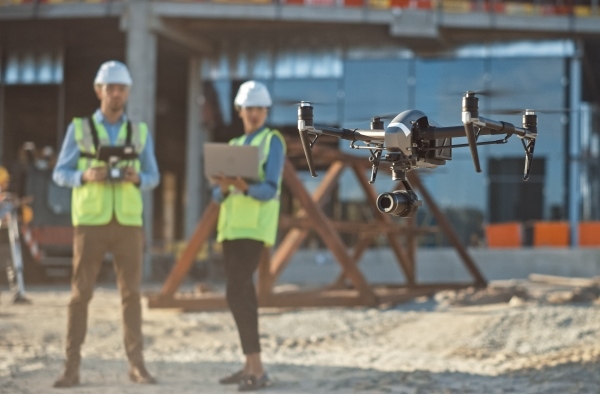
Builders insurance plays a vital role in the construction industry, providing financial protection to building owners, contractors, and other stakeholders against various risks associated with construction projects. However, the industry has been facing several challenges in terms of risk assessment, loss prevention, and claims processing. Traditional methods of risk assessment often rely on manual processes, leading to inefficiencies and inaccuracies. Moreover, loss prevention and claims processing can be slow and costly, resulting in delays and increased costs for all parties involved. The emergence of innovative technologies such as drones, artificial intelligence, and blockchain offers a promising solution to these challenges.
Drones
Drones, also known as unmanned aerial vehicles (UAVs), have become increasingly popular in the construction industry due to their ability to capture high-quality data from remote locations. Drone technology has evolved significantly in recent years, with advancements in battery life, camera quality, and autonomous flight capabilities. In construction, drones can be used for a variety of purposes, including risk assessment, loss prevention, and claims processing.
During the risk assessment phase, drones can be deployed to monitor construction sites, identify potential hazards, and track progress. They can capture detailed images and videos of the site, allowing inspectors to identify potential issues before they become major problems. This proactive approach can help prevent accidents and reduce the likelihood of costly damages.
In addition to risk assessment, drones can be used for real-time monitoring during the construction process. This allows for early detection of damage or defects, enabling prompt intervention and reducing the likelihood of disputes and litigation. By using drones, construction companies can save time and money by addressing issues before they escalate.
With the help of drones, adjusters can conduct faster and more accurate assessments, reducing the need for lengthy site visits and minimising disputes between parties. Drones provide a bird’s eye view of the damage, making it easier to identify and quantify losses. This not only saves time but also reduces the likelihood of litigation, as both parties can agree on the extent of the damage.
Artificial Intelligence
Artificial intelligence (AI) is rapidly transforming the way data is analysed and decisions are made in various industries, and the construction sector is no exception. AI algorithms can quickly process vast amounts of data, identify patterns and trends, and provide valuable insights that humans might miss. In construction, AI can be applied to risk assessment, loss prevention, and claims processing, among other areas.
In risk assessment, AI can leverage historical data and machine learning algorithms to predict potential risks and develop tailored risk management strategies. For instance, AI can analyse data from past projects, weather patterns, and environmental factors to predict the likelihood of certain risks, such as flooding or structural instability. This enables construction companies to take proactive measures to mitigate those risks, reducing the likelihood of costly delays or accidents.
AI can also play a crucial role in loss prevention. By analysing real-time data from sensors, cameras, and other devices, AI algorithms can detect potential hazards and trigger automatic alerts to prevent accidents. For example, AI can monitor temperature levels and detect anomalies that may indicate a fire risk, automatically alerting facility managers to take corrective action. Additionally, AI can optimise safety protocols based on data analysis, ensuring that workers are equipped with the appropriate personal protective equipment and following best practices.
In claims processing, AI can streamline processes, improve accuracy, and enhance the customer experience. AI algorithms can quickly review documentation, identify relevant information, and flag potentially fraudulent claims. This helps adjusters make informed decisions faster, reducing the time and effort required to settle claims. Furthermore, AI-powered chatbots can provide policyholders with quick answers to their questions, improving communication and overall satisfaction.
Blockchain
Blockchain technology is a decentralised, digital ledger that records transactions securely and transparently. It has the potential to transform the construction industry by creating a foundation of trust among stakeholders. In the context of risk assessment, blockchain can be used to create tamper-proof records of project plans, materials, and progress. This ensures that all stakeholders have access to accurate and up-to-date information, reducing the likelihood of misunderstandings and disputes. Additionally, blockchain’s transparency and immutability can help to reduce fraudulent claims, as all transactions and events are recorded and visible to all parties.
In loss prevention, blockchain can be used to securely document and verify the authenticity of materials, equipment, and labour. This reduces the risk of counterfeit or substandard materials being used, which can compromise the integrity of the project. Moreover, blockchain can help to streamline dispute resolution processes by providing a clear and indisputable record of events. This can save time and resources, as well as reduce the likelihood of legal disputes.

In claims processing, blockchain can be used to create efficient and secure payment systems. Smart contracts can be programmed to automatically release payments when certain conditions are met, such as the completion of a milestone or submission of valid documentation. This reduces the administrative burden on all parties, while also increasing trust among stakeholders. Furthermore, blockchain’s transparency and security can help to reduce fraudulent activity, ensuring that payments are made accurately and efficiently.
The Future of Builders Insurance
The future of builders’ insurance is exciting and full of possibilities. With the integration of AI, drones, and blockchain, the industry is poised for significant growth and transformation. These technologies will continue to evolve and improve, offering even more advanced solutions for risk assessment, loss prevention, and claims processing. For instance, AI algorithms will become more sophisticated, able to analyse larger datasets and provide more accurate predictions. Drones will become more advanced, capable of capturing higher-quality data and transmitting it in real-time. Blockchain technology will continue to mature, providing greater security and transparency in data sharing.
Builders, contractors, and insurers should consider embracing these innovations and stay ahead of the curve. By adopting these technologies, they can streamline their operations, reduce costs, and improve customer satisfaction.

